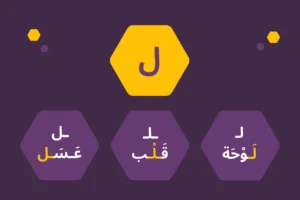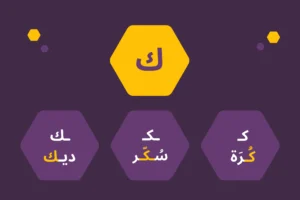Hello, Arabic learners!
Today, we have something special to talk about. You must have seen many Arabic garments if you are a fan of Arabic shows or have been to one of the Arabic countries! Have you ever wondered what these clothes are called? Well, read on to find out everything about traditional Arabic clothes.
Arab culture is one of the world’s richest cultures, especially regarding traditional clothes. These garments usually consist of key pieces such as the thobe for men and the abaya for women. Each one of these clothes represents something rooted in the country’s core.
If you are an Arabic learner, or traveling to one of the Arab countries, or perhaps just curious about that Arab piece of clothing you saw in that movie, you are in the right place!
Let’s discover together the most common Arab clothes and what each one is for.
Common Traditional Arabic Garments (with Meanings & Pronunciation)
Traditional Arab clothing reflects great cultural values across different countries and regions. It usually consists of key pieces such as the thobe for men and the abaya or jilbab for women, in addition to head coverings such as the shemagh and agal. The details, types, and styles of these garments vary from one region to another and are considered a symbol of identity and pride in heritage.
Learning about traditional Arabic clothing will not only improve your Arabic but also make you closer to native speakers and help you understand the Arabic culture.
Below are our top 7 Arabic traditional garments with their pronunciation, meaning, usage context, and visuals to help you connect words to real cultural elements. Let’s unfold them together!
Hijab حِجَاب
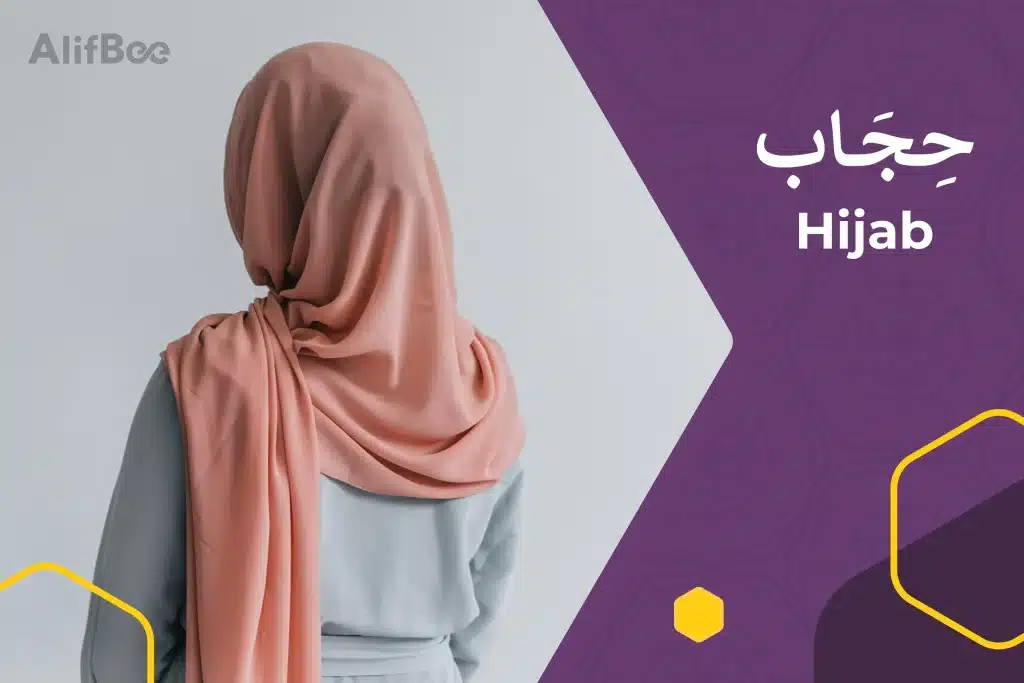
Meaning & When It’s Worn
Pronunciation
Arabic Term
Arabic Script
A covering for the head, hair, or body worn by some women as a religious, cultural, or social symbol.
hee-JAB
hijab
حِجَاب
The hijab is not just a piece of cloth, but a symbol of spiritual identity and an expression of Islamic values.
Facts about hijab:
- Pronunciation: /hee-JAB/ Stressed syllable: JAB
- There are many common misconceptions about the hijab. Some believe that the hijab is imposed on Muslim women. But hijab is a personal choice for Muslim women, not an imposition. It doesn’t necessarily express extremism, but rather an expression of identity and faith.
- Example sentence:
English
Transliteration
Arabic
She wears the hijab at school.
Tartadī al-ḥijāba fī al-madrasah.
تَرتَدِي الحِجَابَ في المَدرسَةِ.
Abaya عباءة
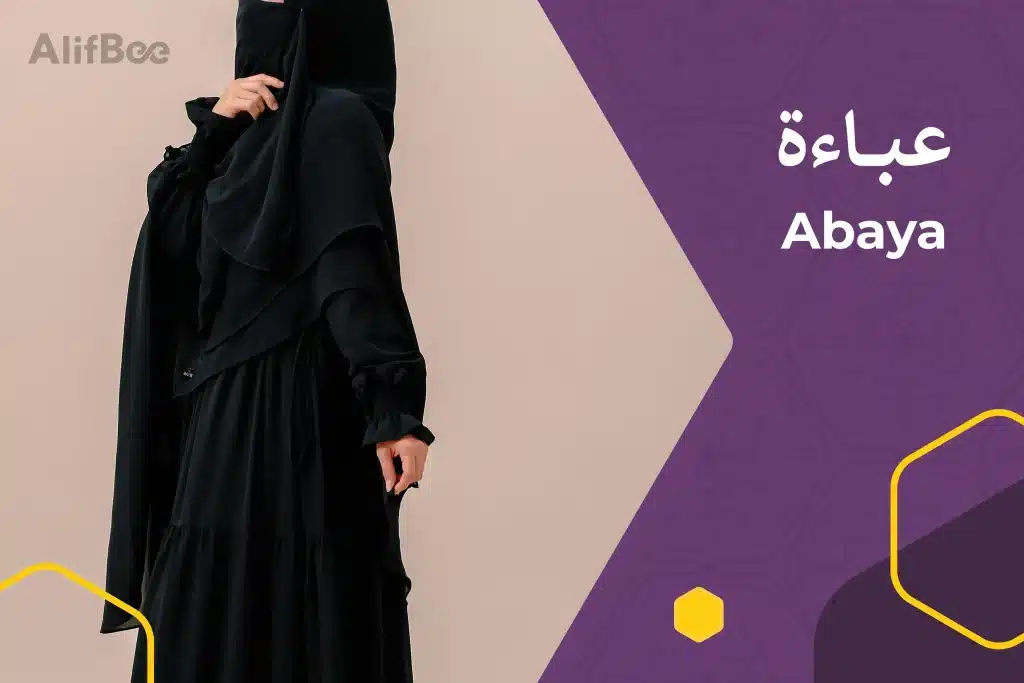
Meaning & When It’s Worn
Pronunciation
Arabic Term
Arabic Script
A long, loose-fitting garment resembling a robe, covering the entire body except for the face, hands, and feet.
a-BAA-ya
abaya
عَبَاءَة
The abaya is a traditional Arabic garment that has a deep cultural meaning. It’s a symbol of identity, modesty, and elegance, and is part of the cultural heritage of the region.
Facts about abaya:
- Pronunciation: /a-BAA-ya/Stressed syllable: BAA
- The abaya is usually worn by Muslim women in the Gulf States and other regions with an Islamic culture.
- It’s often worn when going out of the house.
- Its designs and colors can vary from region to region.
- Example sentence:
English
Transliteration
Arabic
My sister bought a new abaya.
Ishtarat ukhtī ʿabā’ah jadīdah.
اشترَت أُخْتِي عَبَاءَةً جَدِيدَةً.
Keffiyeh كُوفِيَّة
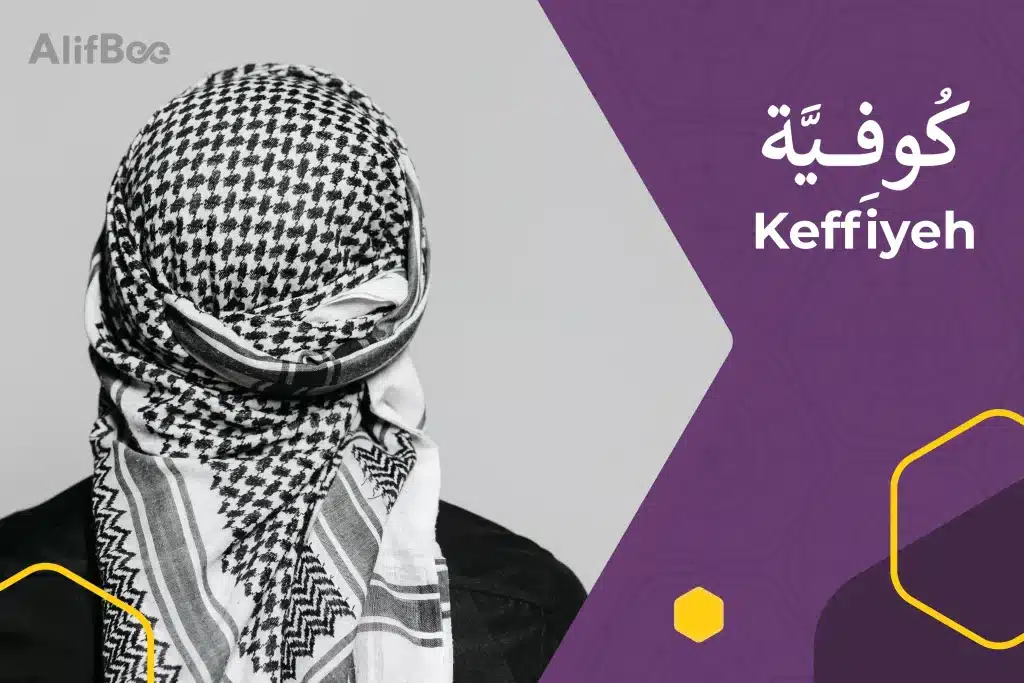
Meaning & When It’s Worn
Pronunciation
Arabic Term
Arabic Script
Headwear consisting of a piece of fabric usually made of cotton or linen and decorated with many colors.
keh-FEE-ya
Keffiyeh
كُوفِيَّةٌ
The keffiyeh is one of the most common traditional Arabic garments. It’s loved by everyone, and almost every Arabic house has it.
Facts about Keffiyeh:
- Pronunciation: /keh-FEE-ya/ Stressed syllable: FEE
- It carries deep cultural and patriotic meanings. It’s a symbol of pride and belonging.
- The keffiyeh can be worn at any time and occasion, whether to express identity, solidarity, or simply as a piece of stylish clothing.
- Keffiyeh, especially in black-and-white, is most famously worn in Palestine and Jordan, often symbolizing culture and resistance.
- Example sentence:
English
Transliteration
Arabic
The keffiyeh is not just a piece of cloth; it’s a symbol.
Al-kūfiyyah laysat mujarrad qiṭʿat qimāsh, bal hiya ramz.
الكُوفِيَّةُ لَيْسَت مُجرَّدَ قِطَعَةِ قِمَاشٍ، بَل هِيَ رَمْز.
Thawb ثَوْب
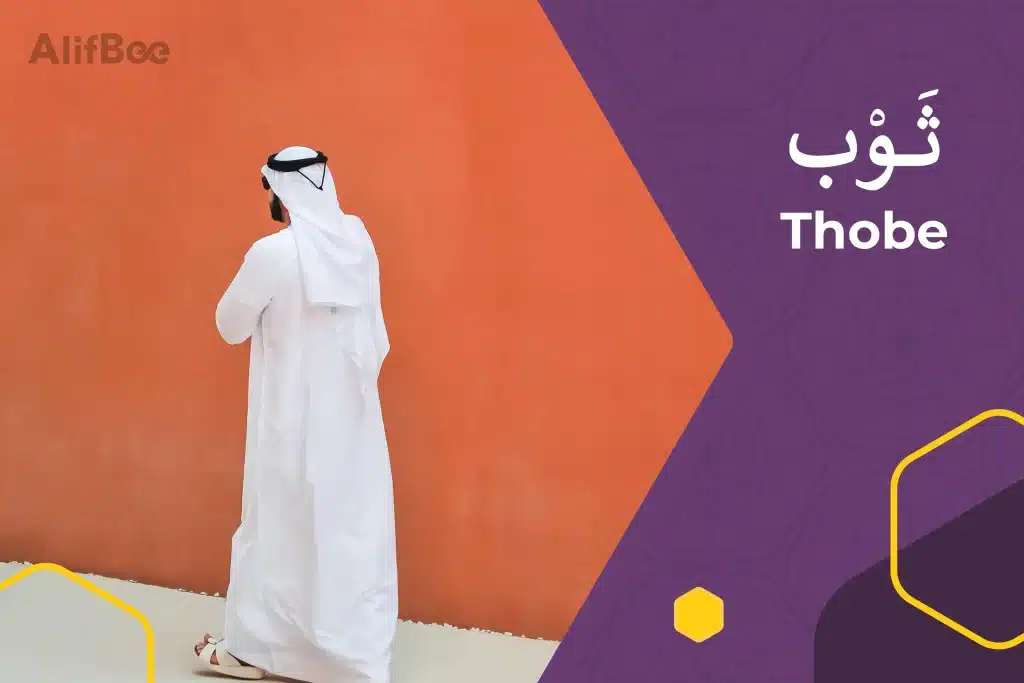
Meaning & When It’s Worn
Pronunciation
Arabic Term
Arabic Script
Traditional men's clothing in the Arab world consists of a long, loose-fitting robe with long sleeves reaching to the ankles.
Thawb
thobe
ثَوْب
Facts about the thobe:
- Pronunciation: /THOBE/
- The thobe is considered a symbol of cultural and national identity in many societies, especially in the Arab world. It contributes to a sense of belonging to a particular group or community, and reflects shared values and customs.
- The thobe is usually worn on official, religious, and social occasions, such as holidays, weddings, and formal meetings, as well as in daily life in some regions. It’s also part of the cultural and traditional identity in some countries, such as Saudi Arabia.
- You’ll spot the thobe most often in Gulf countries like Saudi Arabia, the UAE, and Qatar.
- Example sentence:
English
Transliteration
Arabic
The man wore a white thobe.
Labisa ar-rajulu thoban abyaḍ.
لَبِسَ الرَّجُلُ ثَوبًا أَبْيَضَ.
Bisht بُشْت
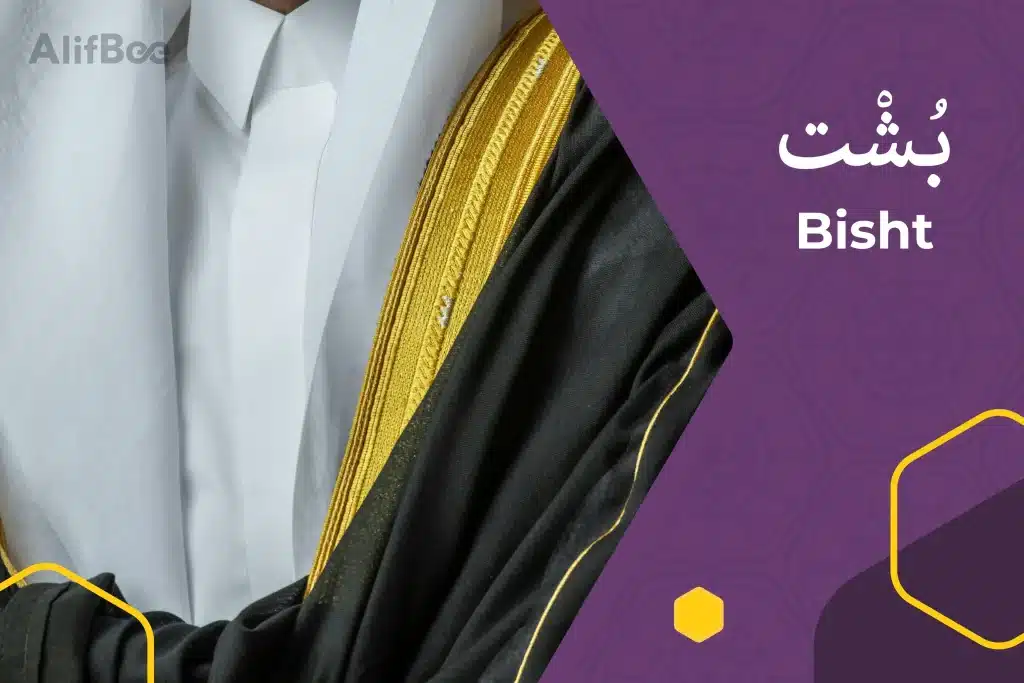
Meaning & When It’s Worn
Pronunciation
Arabic Term
Arabic Script
A traditional Arab man's cloak, often loose-fitting and open at the front, is worn over a thobe.
bisht
bisht
بُشْت
Do you remember that iconic scene at the World Cup Final in 2022 when Qatar Emir Sheikh Tamim placed a traditional Arab garment on Messi? Yes, that’s a bisht!
Facts about bisht:
- Pronunciation: /BISHT/
- The bisht is a traditional Arabic garment that is reflected in its cultural meanings, such as identity, dignity, and pride.
- You’ll usually see the elegant bisht during weddings and big events in Saudi Arabia, Qatar, and other Gulf nations.
- It’s considered a symbol of dignity and elegance.
- Example sentence:
English
Transliteration
Arabic
The man wore a bisht at the wedding.
Irtadā ar-rajul al-bisht fī ḥafl az-zifāf.
ارتَدَى الرَّجُلُ البُشْتَ في حَفْلِ الزَّفَافِ.
Shemagh شِمَاغ
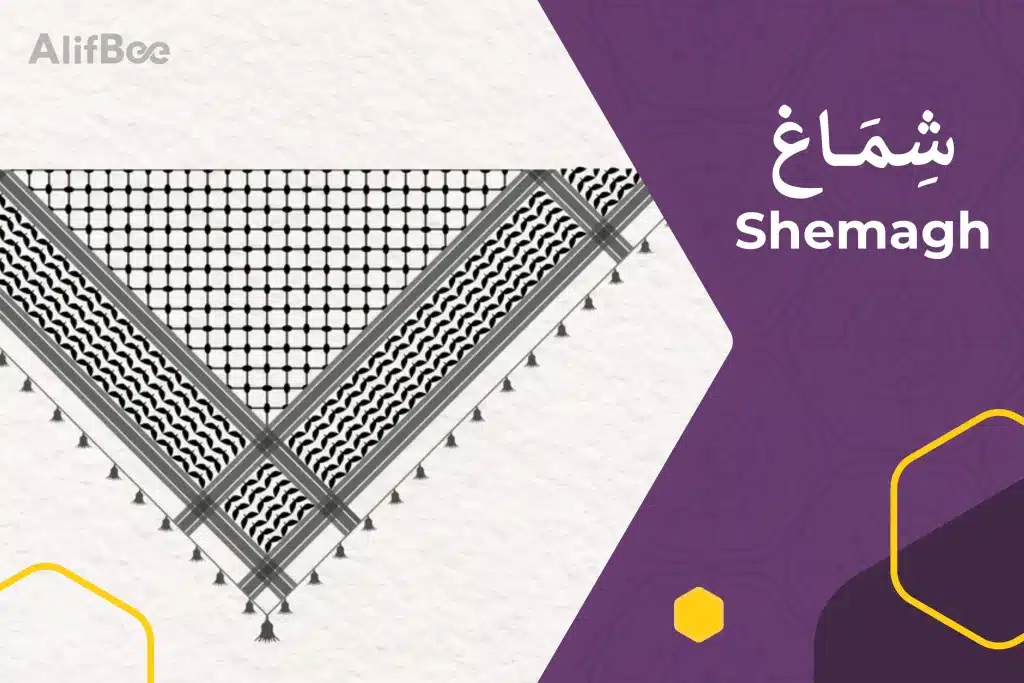
Meaning & When It’s Worn
Pronunciation
Arabic Term
Arabic Script
A traditional head covering for men, usually square, made of cotton or linen, folded into a triangle and placed on the head, secured with an agal.
sheh-MAAGH
shemagh
شِمَاغ
Facts about shemagh:
- Pronunciation: /sheh-MAAGH/ Stressed syllable: MAAGH
- In Arab culture, the shemagh is more than just a piece of cloth; it is a symbol of belonging and tradition.
- It reflects values such as dignity and honor.
- The shemagh is favored on formal and social occasions and is considered part of the traditional costume in many Arab countries, especially in the Gulf region, Jordan, and Iraq.
- Example sentence:
English
Transliteration
Arabic
I love wearing a shemagh.
Uḥibb irtidā’ ash-shimāgh.
أُحِبُّ ارتِدَاءَ الشِّمَاغ.
Agal عِقَال
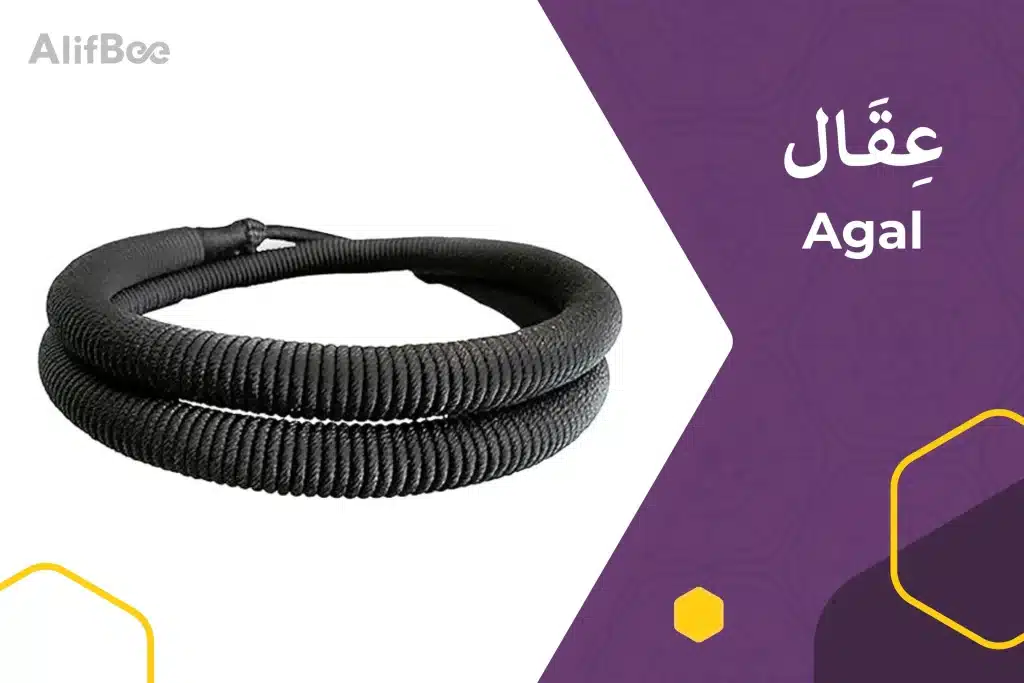
Meaning & When It’s Worn
Pronunciation
Arabic Term
Arabic Script
A piece of traditional Arab clothing worn by men, consisting of a circular ring, often black, worn over the shemagh to secure it on the head.
a-GAHL
agal
عِقَال
Facts about agal:
- Pronunciation: /a-GAHL/ Stressed syllable: GAHL
- The agal is a symbol of prestige that reflects social status and an appreciation of cultural values.
- The black agal is that stylish cord men wear over a shemagh, and it’s common in the Gulf region as part of formal traditional dress
- Example sentence:
English
Transliteration
Arabic
The man wore a black agal.
Irtadā ar-rajul ʿigāl aswad.
ارتَدَى الرَّجُلُ عِقَالًا أَسْوَدَ.
Discover More with AlifBee
Now that you know the most common Arabic garments, you are more aware of the Arabic culture, and you will feel more connected to the culture and people as well.
This knowledge will help you understand the Arabic environment, its values, and will also help you avoid any misinterpretations.
Improve your Arabic language with AlifBee, and let’s take your Arabic to the next level!






